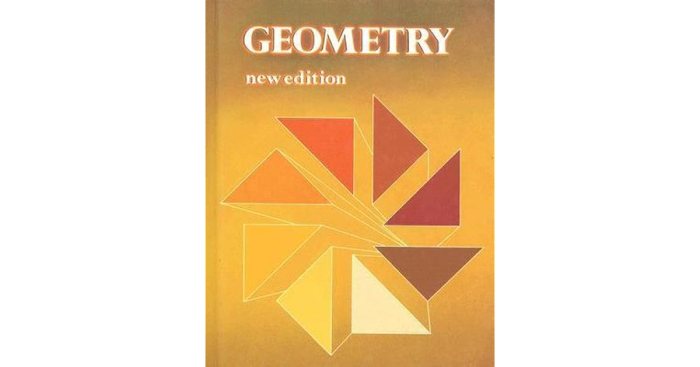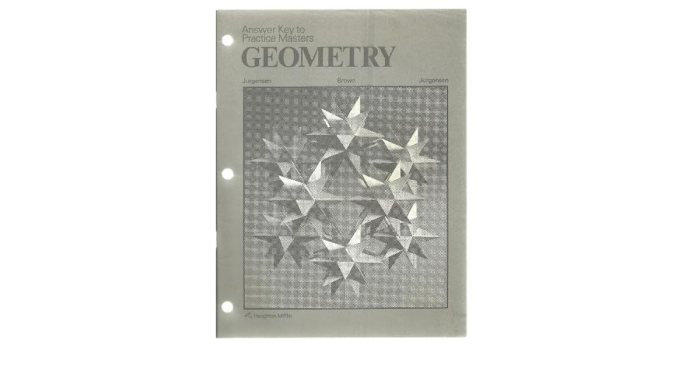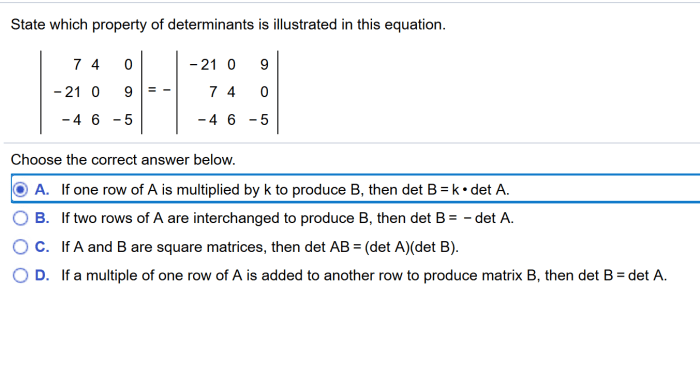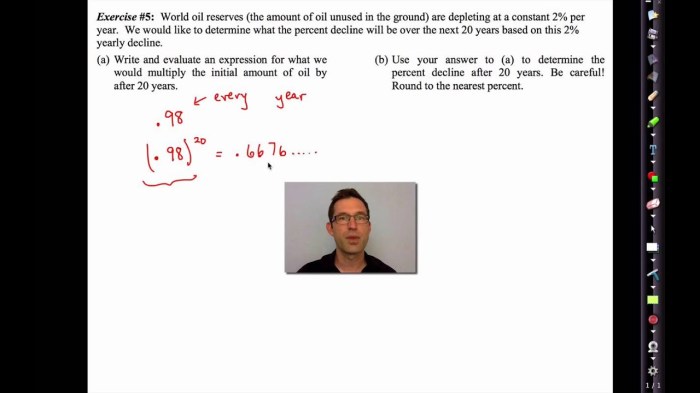Geometry by Ray C. Jurgensen takes center stage, inviting us on an enthralling journey into the realm of shapes, theorems, and their captivating applications in our world. Prepare to be captivated as we delve into the fundamental principles that govern the geometry that surrounds us, unlocking a deeper understanding of our physical surroundings.
From the axiomatic approach that forms the bedrock of geometry to the practical applications that shape our built environment, this comprehensive exploration unravels the intricacies of this fascinating field, leaving no stone unturned.
Key Concepts in Geometry by Ray C. Jurgensen

Geometry by Ray C. Jurgensen introduces the foundational principles of geometry through an axiomatic approach. The book provides a comprehensive overview of key concepts, laying the groundwork for further exploration in the field.
Fundamental Principles of Geometry
Geometry is built upon a set of axioms, or self-evident truths, which form the basis for all geometric theorems and proofs. These axioms define the fundamental properties of points, lines, planes, and angles, providing a framework for understanding geometric relationships.
Key Concepts
The book covers a wide range of key concepts in geometry, including:
- Points: Fundamental building blocks of geometry, representing locations in space.
- Lines: One-dimensional objects extending infinitely in both directions.
- Planes: Two-dimensional surfaces extending infinitely in all directions.
- Angles: Measures of the amount of rotation between two lines or planes.
Axiomatic Approach
Jurgensen’s axiomatic approach to geometry emphasizes the importance of logical reasoning and deduction. By starting with a set of axioms, the book builds a rigorous and coherent system of geometric knowledge, allowing students to derive new theorems and solve problems through logical inference.
Applications of Geometry in Real-World Scenarios: Geometry By Ray C. Jurgensen

Geometry finds its practical applications in a wide array of fields, including architecture, engineering, and design. Its principles are crucial for understanding and manipulating our physical surroundings, from the construction of buildings to the design of intricate machines.
Architecture, Geometry by ray c. jurgensen
In architecture, geometry plays a pivotal role in determining the shape, structure, and aesthetics of buildings. Architects use geometric principles to ensure the stability and functionality of structures, as well as to create visually appealing designs. The use of geometric shapes, such as squares, circles, and triangles, allows architects to create spaces that are both functional and aesthetically pleasing.
- The Parthenon in Greece is a classic example of the use of geometry in architecture. Its rectangular shape and symmetrical columns demonstrate the principles of balance and proportion.
- Modern skyscrapers often incorporate geometric shapes, such as cubes and pyramids, to create striking and iconic structures.
Engineering
Geometry is essential in engineering for designing and constructing structures that are both efficient and safe. Engineers use geometric principles to calculate the strength and stability of bridges, buildings, and other structures.
Geometry by Ray C. Jurgensen provides an in-depth exploration of geometric concepts. For those seeking practice questions, nbme psych form 2 answers offers a comprehensive resource. Returning to Geometry by Ray C. Jurgensen, the text’s clear explanations and engaging examples make it an invaluable tool for students looking to master geometry.
- Civil engineers use geometry to design roads, bridges, and other infrastructure, ensuring their safety and durability.
- Mechanical engineers use geometry to design machines, such as engines and robots, that are both efficient and functional.
Design
Geometry is also used in design, including graphic design, product design, and interior design. Designers use geometric shapes and principles to create visually appealing and functional designs.
- Graphic designers use geometry to create logos, brochures, and other visual materials that are both eye-catching and informative.
- Product designers use geometry to create products that are both aesthetically pleasing and ergonomic.
Geometric Proofs and Theorems

Geometric proofs and theorems play a crucial role in geometry, providing a logical framework for establishing the validity of geometric statements. These tools allow us to deduce new knowledge from known facts, extending our understanding of geometric concepts.
Methods of Geometric Proofs
Geometric proofs employ deductive reasoning, a logical process that involves drawing conclusions from a set of given statements (premises). Two primary methods of deductive reasoning are used:
- Direct Proof:A direct proof establishes the truth of a statement by presenting a logical sequence of steps that leads to the desired conclusion.
- Indirect Proof:Also known as proof by contradiction, an indirect proof assumes the negation of the statement to be proven. If this leads to a contradiction, then the original statement must be true.
Major Theorems and Postulates
Geometry relies on a foundation of theorems and postulates, which are fundamental truths that serve as building blocks for geometric proofs.
Theorems
- Pythagorean Theorem:Relates the lengths of the sides of a right triangle.
- Triangle Inequality Theorem:States that the sum of the lengths of any two sides of a triangle is greater than the length of the third side.
- Angle Bisector Theorem:Divides an angle into two equal parts and bisects the opposite side.
Postulates
- Segment Addition Postulate:States that the length of a segment is equal to the sum of the lengths of its parts.
- Angle Addition Postulate:States that the measure of an angle is equal to the sum of the measures of its parts.
- Parallel Postulate:States that through a point not on a given line, there is exactly one line that is parallel to the given line.
Constructing Geometric Proofs
To construct a geometric proof, follow these steps:
- State the given information:List the premises and any relevant definitions or theorems.
- Write a series of logical statements:Each statement should follow logically from the previous ones, using theorems and postulates as justification.
- Conclude with the desired statement:The final statement should be the geometric statement that you set out to prove.
Geometric proofs are essential for establishing the validity of geometric claims and extending our understanding of geometric relationships.
Coordinate Geometry and Transformations
Coordinate geometry, also known as analytic geometry, is a branch of mathematics that uses algebraic equations to represent and analyze geometric figures. It provides a systematic way to describe the position and relationships between points, lines, curves, and other geometric objects in a coordinate plane.
Coordinate geometry has numerous applications in various fields, including physics, engineering, computer graphics, and architecture. It allows for the precise representation and manipulation of geometric shapes, making it a valuable tool for solving problems involving distance, area, volume, and other geometric properties.
Geometric Transformations
Geometric transformations are operations that map one geometric figure to another. They preserve certain geometric properties while altering others. The three main types of geometric transformations are translations, rotations, and reflections.
- Translationsinvolve moving a figure from one point to another without changing its size or shape.
- Rotationsinvolve turning a figure around a fixed point by a specified angle.
- Reflectionsinvolve flipping a figure over a line or plane, creating a mirror image.
Geometric transformations are used extensively in various applications, such as computer graphics, animation, and engineering. They allow for the manipulation and analysis of geometric shapes in a precise and efficient manner.
Advanced Topics in Geometry
As the study of geometry advanced, mathematicians began exploring concepts beyond Euclidean geometry, which had been the foundation of the field for centuries. These advanced topics, such as non-Euclidean geometry and topology, opened up new avenues of research and led to a deeper understanding of the nature of space and shape.
Non-Euclidean geometry challenged the long-held assumptions about the nature of lines, angles, and triangles. In Euclidean geometry, the parallel postulate states that given a line and a point not on the line, there is exactly one line that can be drawn through the point parallel to the given line.
However, in non-Euclidean geometries, this postulate does not hold true. There are two main types of non-Euclidean geometry: hyperbolic geometry and elliptic geometry. In hyperbolic geometry, the parallel postulate is replaced by the assumption that there are infinitely many lines that can be drawn through a point parallel to a given line.
In elliptic geometry, the parallel postulate is replaced by the assumption that there are no lines that can be drawn through a point parallel to a given line.
Topology is another advanced topic in geometry that deals with the study of shapes and their properties without regard to their size or shape. Topologists are interested in questions such as how many holes a shape has, how many connected components it has, and whether it is orientable or not.
Topology has applications in many areas of mathematics, including knot theory, graph theory, and algebraic geometry.
The historical development of non-Euclidean geometry and topology is a fascinating story that spans centuries. The first major breakthrough in non-Euclidean geometry came in the 19th century when the mathematicians Nikolai Lobachevsky and János Bolyai independently developed hyperbolic geometry. Elliptic geometry was developed a few years later by the mathematician Bernhard Riemann.
Topology emerged as a separate branch of mathematics in the late 19th century, with the work of mathematicians such as Henri Poincaré and Felix Klein.
Today, non-Euclidean geometry and topology are active areas of research. Mathematicians are working to develop new and more general theories of geometry, and to apply these theories to problems in other areas of mathematics and science. For example, non-Euclidean geometry has been used to model the shape of the universe, and topology has been used to study the structure of DNA.
Helpful Answers
What is the axiomatic approach to geometry?
The axiomatic approach establishes a set of fundamental assumptions, or axioms, that serve as the foundation for geometric reasoning. These axioms define the basic properties of geometric objects and their relationships, providing a framework for deducing further truths.
How is geometry used in real-world applications?
Geometry finds widespread applications in architecture, engineering, design, and many other fields. It provides the principles for designing structures, analyzing forces, and creating aesthetically pleasing forms.
What are some key geometric theorems?
Geometry by Ray C. Jurgensen introduces numerous important theorems, including the Pythagorean theorem, which relates the lengths of sides in a right triangle, and the angle bisector theorem, which establishes the relationship between the angle bisector and the sides of a triangle.
What is coordinate geometry?
Coordinate geometry uses a coordinate system to represent geometric figures on a plane. This allows for precise measurements and transformations of shapes, making it a powerful tool for geometric analysis.
What are some advanced topics in geometry?
Advanced topics in geometry include non-Euclidean geometry, which explores geometries that differ from Euclidean geometry, and topology, which studies the properties of shapes that remain unchanged under continuous deformations.


